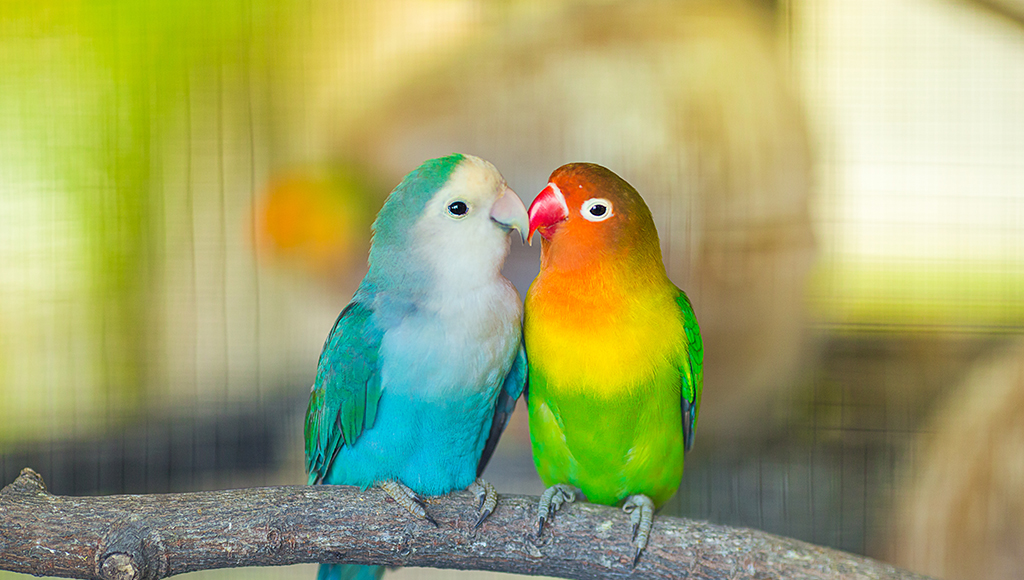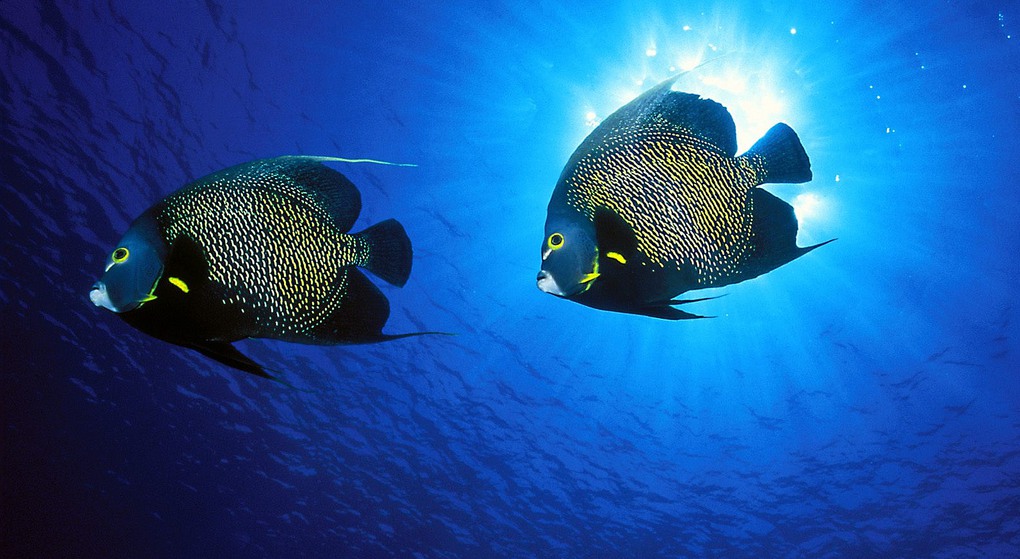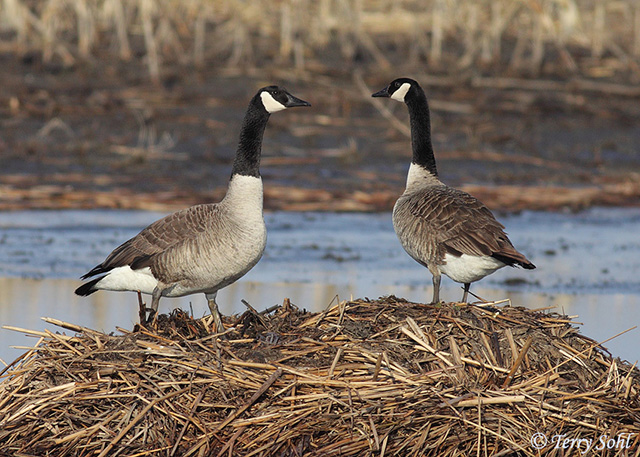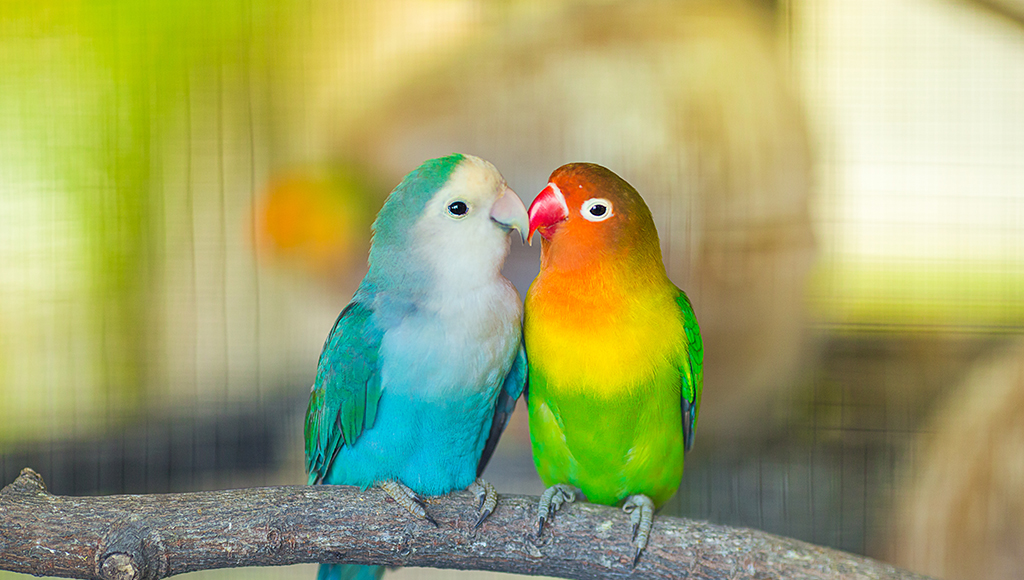Love is not just a human emotion, and many animals display signs of affection, care for each other, and protect their families. Some of them mate for life, while others will mate again if their mate dies.
From the elegant French Angelfish to the tiny Lovebirds, animals in love go beyond just mating for life. In this article, we will explore the top 10 most romantic animals in the world, according to various sources.
You are reading: Top 10 Most Romantic Animals In The World
These animals share a beautiful courtship ritual, form strong, lifelong bonds with their partners, and have an affectionate nature that has made them symbols of love and marriage.

Top 10 Most Romantic Animals In The World
French Angelfish

The French Angelfish (Pomacanthus paru) is a beautiful and friendly fish that has become a symbol of love and monogamy in the animal kingdom. Here are some interesting facts about this romantic fish:
– French Angelfish manifest permanent pairing, having the same mate for life.
– They swim slowly side-by-side with their partner and defend their territory against other fish.
– French Angelfish are one of the few monogamous fish species.
– They form close, monogamous pairs from a young age and then do everything with their mate for life.
– French Angelfish are not only attractive but also have a friendly disposition with their keeper.
– They are popular among snorkelers and divers, as they can be found in shallow waters.
The French Angelfish’s romantic nature and lifelong commitment to their partner make them a fascinating species to observe in the wild or in aquariums.
Prairie Vole
The Prairie Vole (Microtus ochrogaster) is a small rodent found in central North America. Here are some interesting facts about this romantic animal:
– Prairie voles are known for their monogamous behavior, forming lifelong bonds with their partners.
– They mate for life, sharing nest-building duties and an equal role in raising their young.
– Prairie voles breed throughout the year except during severe winters and summers, with the highest levels of reproductive activity occurring between May and October.
– In the laboratory, a pair-bonded vole will work for access to its mate, and they even exhibit something like empathy for their partners, getting stressed when they are stressed, and consoling each other through touch.
– Prairie voles have long been of interest to scientists looking at the neurobiology of bonding and monogamy.
– A molecular signature found in the brains of monogamous prairie voles begins to decay after a breakup, and the voles can recover from a broken heart.
– Prairie voles are an extensively studied model for understanding the neural mechanisms underlying social behavior and addiction.
The Prairie Vole’s monogamous behavior and lifelong commitment to their partner make them a fascinating species to study and learn from.
Goose

Canada Goose
April 24th, 2011
Minnehaha County, South Dakota
Canon 50D, 400 5.6L
The Canada Goose (Branta canadensis) is a large waterbird native to North America, Mexico, and Canada. Here are some interesting facts about this romantic animal:
– Canada Geese mate for life and are known for their strong pair bonds.
– They are monogamous and will only look for a new mate if their partner dies.
– Canada Geese are highly social animals and often travel in pairs or family groups.
– They are known for their distinctive honking calls, which they use to communicate with their mate and family.
– Canada Geese are also known for their elaborate courtship displays, which involve head bobbing, neck stretching, and vocalizations.
– They build their nests together and share the responsibilities of incubating the eggs and raising the young.
– Canada Geese are adaptable birds and can be found in a variety of habitats, including urban parks, suburban areas, and agricultural fields.
Read more : 8 Types Of Water Snakes
The Canada Goose’s strong pair bonds and elaborate courtship displays make them a fascinating species to observe in the wild.
Fox
The Red Fox (Vulpes vulpes) is a small carnivorous mammal found throughout the Northern Hemisphere. Here are some interesting facts about this romantic animal:
– Red Foxes are monogamous and form strong pair bonds that can last for life.
– They mate in the winter months, and the female gives birth to a litter of pups in the spring.
– Both parents share the responsibilities of raising the young, with the male bringing food to the den and the female nursing and caring for the pups.
– Red Foxes are known for their playful and affectionate behavior with their mate, often grooming each other and engaging in social grooming.
– They are also known for their elaborate courtship displays, which involve chasing, jumping, and vocalizations.
– Red Foxes are highly adaptable and can be found in a variety of habitats, including forests, grasslands, and urban areas.
– They are also known for their intelligence and cunning, making them a popular subject in folklore and literature.
The Red Fox’s monogamous behavior and affectionate nature with their mate make them a fascinating species to observe in the wild.
Albatross
The Albatross is a family of large seabirds that spend most of their time far away from land. They are known for their impressive wingspan, which can reach up to 11 feet, making them the bird with the longest wingspan in the world.
Here are some interesting facts about this romantic animal:
– Albatrosses are monogamous and form strong pair bonds that can last for life.
– They mate for life and only look for a new mate if their partner dies.
– Albatrosses are known for their elaborate courtship displays, which involve dancing, bill clacking, and vocalizations.
– They breed on remote islands, where they form large colonies.
– Both parents share the responsibilities of incubating the egg and raising the chick.
– Albatrosses are long-lived birds, with some individuals reaching up to 50 years of age.
– They are threatened by habitat loss, pollution, and overfishing, and many species are considered endangered.
The Albatross’s monogamous behavior and elaborate courtship displays make them a fascinating species to observe in the wild.
River Otter
The North American River Otter (Lontra canadensis) is a semiaquatic mammal that only lives on the North American continent, along its waterways and coasts. Here are some interesting facts about this romantic animal:
Description
– Adult North American River Otters can weigh between 5.0 and 14 kg (11.0 and 30.9 lb).
– They have a thick, water-repellent coat of fur that protects and insulates them.
– River otters have short legs, webbed feet for faster swimming, and a long, narrow body and flattened head for streamlined movement in the water.
– They have long whiskers, which they use to detect prey in dark or cloudy water, and clawed feet for grasping onto slippery prey.
Behavior
– North American River Otters are highly social animals and often travel in pairs or family groups.
– They are known for their playful and affectionate behavior with their mate, often grooming each other and engaging in social grooming.
– River Otters are monogamous and form strong pair bonds that can last for life.
– Both parents share the responsibilities of incubating the egg and raising the young.
– They prefer unpolluted water with minimal human disturbance and exhibit a variety of vocalizations, ranging from whistles and buzzes to twitters, staccato chuckles, chirps, and growls.
The North American River Otter’s playful and affectionate behavior with their mate make them a fascinating species to observe in the wild.
Barn Owl
The Barn Owl (Tyto alba) is a medium-sized, pale-colored owl with long wings and a short, squarish tail. Here are some interesting facts about this fascinating bird:
Appearance
– Barn Owls have a distinctive heart-shaped face and a white, heart-shaped facial disc that helps them locate prey in the dark.
– They have long, rounded wings and short tails, which combine with a buoyant, loping flight to give them a distinctive flight style.
– The legs are long and the head is smoothly rounded, without ear tufts.
– Barn Owls are typically 12.6-15.8 inches (32-40 cm) in length, with a wingspan of 39.4-49.2 inches (100-125 cm).
Behavior
– Barn Owls are silent predators of the night world and are strictly nocturnal.
– They are known for their excellent low-light vision and ability to locate prey by sound alone, which is the best of any animal that has ever been tested.
– Barn Owls are monogamous and form strong pair bonds that can last for life.
– They are cavity nesters and often inhabit barns and other old, abandoned buildings.
– Both parents share the responsibilities of incubating the eggs and raising the young.
– Barn Owls don’t hoot like most other owls, but instead make harsh screeches at night.
Despite their worldwide distribution, Barn Owls are declining in parts of their range due to habitat loss. The Barn Owl’s unique appearance and behavior make them a fascinating species to observe in the wild.
Lovebirds

Read more : 20 Beautiful Types Of Guppy Fish
Lovebirds are small parrots that are known for their loving, attentive bond they tend to form with their mates. Here are some interesting facts about these fascinating birds:
Appearance
– Lovebirds are among the smallest parrots, measuring between 5 to 7 inches in length and weighing between 40 to 60 g.
– They have a stocky build, a short blunt tail, and a relatively large, sharp beak.
– Wildtype lovebirds are mostly green with a variety of colors on their upper body, depending on the species.
– Lovebirds are available in a number of color mutations.
Behavior
– Lovebirds are monogamous and form strong pair bonds that can last for life.
– They are highly social animals and often travel in pairs or small flocks.
– Both parents share the responsibilities of incubating the eggs and raising the young.
– Lovebirds are known for their playful and affectionate behavior with their mate, often grooming each other and engaging in social grooming.
– They are not among the species that most would consider talking birds, but they have the ability to mimic human speech.
Lovebirds are popular pets due to their small size, affectionate nature, and beautiful colors. However, it is important to be aware of the danger spots in the house when keeping lovebirds or other pet birds at home, such as open toilet bowls for drowning and clear glass walls which might be rammed in full.
Seahorses
Seahorses are fascinating marine creatures that belong to the genus Hippocampus, which includes 46 different species. Here are some interesting facts about seahorses:
Appearance
– Seahorses are named for their equine appearance, with bent necks and long snouted heads and a distinctive trunk and tail.
– They range in size from 1.5 to 35 cm (0.6 to 13.8 in) and are among the smallest fish in the world.
– Seahorses have a segmented bony armor, an upright posture, and a curled prehensile tail.
– They do not have scales but rather thin skin stretched over a series of bony plates, which are arranged in rings throughout their bodies.
– Each species has a distinct number of rings.
Behavior
– Seahorses are monogamous and form strong pair bonds that can last for life.
– They are highly social animals and often travel in pairs or small groups.
– Both parents share the responsibilities of incubating the eggs and raising the young.
– Seahorses are poor swimmers and rely on their dorsal fin beating at 30-70 times per second to propel them along.
– They are found in tropical and temperate coastal waters, swimming upright among seaweed and other plants.
– Seahorses are threatened by habitat loss, pollution, and overfishing, and many species are considered endangered.
Seahorses are fascinating creatures that have captured the attention of people around the world. Their unique appearance and behavior make them a popular subject for study and observation.
Elephants
Elephants are fascinating animals that have captured the attention of people around the world. Here are some interesting facts about these gentle giants:
Appearance
– Elephants are the largest existing land animals, with the African bush elephant being the largest of the three species.
– They have a long proboscis called a trunk, tusks, large ear flaps, pillar-like legs, and tough but sensitive grey skin.
– Both male and female African elephants grow tusks, which are elongated incisor teeth that can reach up to 3 meters in length.
– Elephants have a distinctive shape and are easily recognizable, with their large size and unique features.
Behavior
– Elephants are highly social animals and often travel in large herds, led by a matriarch.
– They are known for their intelligence, empathy, and complex social behavior.
– Elephants are monogamous and form strong pair bonds that can last for life.
– Both parents share the responsibilities of raising the young, with the mother providing milk and the father providing protection.
– Elephants are herbivores and can consume hundreds of pounds of plant matter in a single day.
– They are threatened by habitat loss, poaching, and human-wildlife conflict, and many species are considered endangered.
Elephants are a symbol of strength, intelligence, and empathy, and their unique appearance and behavior make them a fascinating species to observe in the wild.
FAQS
1. What makes an animal romantic?
Animals that are considered romantic are those that display signs of affection, care for each other, and protect their families. Some of them mate for life, while others will mate again if their mate dies.
2. What are the top 10 most romantic animals in the world?
According to various sources, the top 10 most romantic animals in the world are French Angelfish, Prairie Vole, Goose, Fox, Albatross, River Otter, Barn Owl, Lovebirds, Seahorses, and Elephants.
3. Do all animals mate for life?
No, not all animals mate for life. While some animals, such as French Angelfish and Prairie Voles, are monogamous and mate for life, others may mate with multiple partners throughout their lifetime.
4. Are all romantic animals birds?
No, not all romantic animals are birds. While many of the animals on the list are avian, there are also mammals and even marine vertebrates that are capable of becoming rather attached to their partners of choice.
5. Why are some of these animals endangered?
Many of these animals are threatened by habitat loss, pollution, and overfishing, and many species are considered endangered. It is important to protect these animals and their habitats to ensure their survival for future generations.
Source: https://petstutorial.com
Category: Animals










